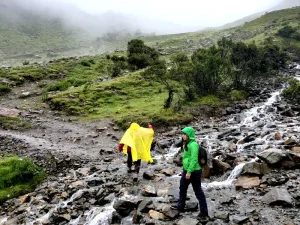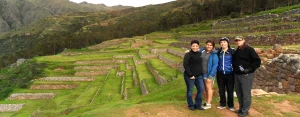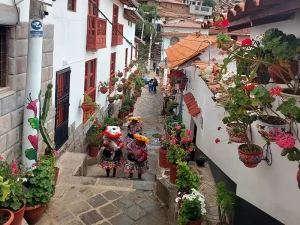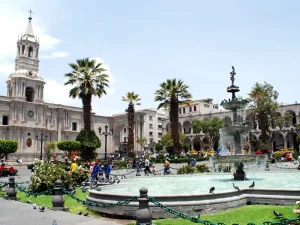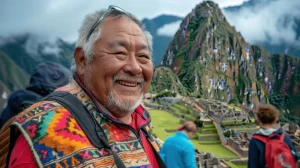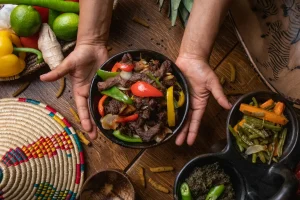The Beating Heart of the Andes
When you first arrive in Cusco, the air feels different—not just because of the altitude, but because of the energy that vibrates through its cobblestone streets and ancient walls. As a Cusqueño and guide, I often tell visitors that Cusco is not just a city—it’s a living museum where every stone whispers stories of the Inca Empire and every plaza hums with Andean traditions.
Imagine standing in the Plaza de Armas at sunset, the golden rays painting the colonial balconies, while Quechua-speaking women in traditional skirts walk by carrying colorful textiles. It is in this magical setting that your journey begins. Let me take you through the top 9 things you simply cannot miss in Cusco City.
Why Visit Cusco?
If you are wondering whether Cusco is worth more than a quick stop on the way to Machu Picchu, let me assure you—it absolutely is. Cusco is the kind of place that reveals itself little by little, like opening the pages of an ancient book.
Here’s why so many travelers, including myself as a local guide, fall in love with Cusco:
- Living Inca heritage: You don’t just learn about the Incas—you walk their streets, touch their stones, and hear their stories still told in Quechua.
- World-class gastronomy: Cusco has become a hub for Peruvian cuisine, from traditional Andean dishes to modern fusion restaurants.
- Festivals all year long: Every month offers a new celebration—colorful parades, traditional dances, and sacred rituals.
- Adventure at your doorstep: From Cusco, you can reach the Sacred Valley, Rainbow Mountain, Humantay Lake, and more within a day.
- Atmosphere: Unlike many cities, Cusco keeps its authenticity alive. Even in modern times, spirituality, nature, and tradition walk hand in hand here.
Local Reflection: As a Cusqueño, I always say that Cusco is not a destination—it’s an experience that touches both your eyes and your soul.
What is Cusco’s Elevation?
One of the first things visitors notice when stepping off the plane is the thin, crisp mountain air. Cusco sits proudly at an elevation of 3,400 meters (11,150 feet) above sea level.
- What this means: At this height, oxygen levels are lower, and some travelers may feel the effects of altitude sickness (soroche).
- How to adapt:
- Drink coca tea or chew coca leaves, a natural Andean remedy.
- Rest the first day and avoid heavy meals.
- Stay hydrated and move slowly—there’s no rush in Cusco!
- Fun fact: Despite its altitude, Cusco’s streets are always lively. Locals are used to it, and within a couple of days, most visitors adjust comfortably.
Local Tip: Don’t be afraid of the altitude—it is part of the adventure, and with the right preparation, you’ll enjoy Cusco fully.
Why Cusco Matters – More Than Just the Gateway to Machu Picchu
Most travelers know Cusco as the starting point to Machu Picchu, but the city itself is a treasure chest. It was once the capital of the Inca Empire, known as the navel of the world. Today, it blends Inca foundations with Spanish colonial architecture, vibrant markets, and living traditions.
Here’s why Cusco deserves your full attention:
- Cultural depth: Museums, temples, and sacred ruins tell the story of two worlds merging—Inca and Spanish.
- Living traditions: Festivals like Inti Raymi keep ancient ceremonies alive.
- Gastronomy: From alpaca steak to street food tamales, Cusco’s cuisine is a feast.
- Atmosphere: A unique blend of mysticism, adventure, and warm hospitality.
Relaxing activities to do in Cusco
1. Explore the Historic Plaza de Armas
Every road in Cusco leads to this magnificent square, which was once the ceremonial heart of the Inca Empire. Known as Huacaypata in Quechua, this plaza witnessed historic events, from Inca celebrations to Spanish executions.
The Plaza de Armas is the beating heart of Cusco. Once the main ceremonial center of the Incas, it now hosts colonial churches, lively restaurants, and street performers.
What to experience:
- Cusco Cathedral: Built on the site of an Inca palace, it houses nearly 400 colonial paintings, including Marcos Zapata’s famous The Last Supper with a roasted guinea pig (cuy) on the table.
- Church of La Compañía de Jesús: Its stunning baroque facade rivals the cathedral’s grandeur.
- Stone of the Twelve Angles: Just off the plaza on Hatun Rumiyoc street, marvel at this perfectly fitted Inca stone that has become an icon of ancient engineering.
Local Tip: Visit at night when the square glows under yellow streetlights—it feels like stepping into a painting.
Best time to visit: Early morning or evening when the light is soft and the crowds are thinner.
2. Visit the Qorikancha – Temple of the Sun
Before the Spanish arrived, the Qorikancha was the most sacred temple in the Inca Empire, dedicated to Inti, the Sun God. Its walls were once plated in solid gold, and its gardens featured life-sized gold and silver sculptures. Today, it represents one of the most fascinating examples of cultural fusion in the world.
Why it matters:
The conquistadors built the Church of Santo Domingo atop its flawless stone foundations—a powerful symbol of conquest and resilience. The seamless blend of Inca masonry and Spanish colonial architecture tells a story of collision and coexistence.
- Why visit: The perfect example of how Inca precision stonework blended with colonial Spanish architecture.
- Don’t miss: The curved Inca wall—so perfectly built that not even a blade of grass can fit between the stones.
Local’s tip: Visit in the late afternoon when the sunlight bathes the ancient stones in a golden glow. Notice how the trapezoidal doors and windows, classic Inca architectural features, have withstood centuries of earthquakes that damaged the colonial structures built atop them.
3. Wander Through San Pedro Market
Forget tourist restaurants—the real flavors of Cusco are found in this bustling market that has operated since the 1920s. This is where locals shop, eat, and socialize.
If you want to feel the real pulse of Cusco, go to San Pedro Market. Here, the air is filled with aromas of herbs, cheese, roasted chicken, and freshly baked bread.
What to try:
- Fresh fruit juices: Ask for jugo especial with exotic fruits like lucuma, cherimoya, or aguaymanto.
- Traditional foods: Sample choclo con queso (Andean corn with cheese), empanadas, or lechón (suckling pig).
- Natural medicines: Discover stalls selling traditional remedies, including coca leaves for altitude sickness.
Local’s insight: The market is organized by sections: fruits and vegetables near the entrance, meats in the middle, and handicrafts and medicines toward the back. Come hungry and curious!
4. Climb to Sacsayhuamán Fortress
High above Cusco, the massive walls of Sacsayhuamán showcase the genius of Inca engineering. Some stones weigh more than 100 tons, yet they fit together perfectly without mortar.
Towering over Cusco, this massive ceremonial fortress showcases the Incas’ architectural genius. The name sounds like “sexy woman” to tourists, but in Quechua it means “satisfied falcon.”
Why it’s extraordinary:
- The largest stones weigh over 100 tons and were transported from quarries miles away without wheels.
- The zigzagging walls represent the teeth of the puma, whose shape Cusco was designed to resemble.
- The precision of the stone-cutting is so exact that not even a piece of paper fits between blocks.
- Best experience: Visit during the Inti Raymi festival (June 24th) when the largest Inca celebration reenacts ancient ceremonies with hundreds of participants in traditional dress.
- Viewpoint: The panoramic view of Cusco City from here is breathtaking.
5. Walk the San Blas Neighborhood
San Blas is Cusco’s bohemian district, full of narrow streets, white houses with blue balconies, and artisan workshops.
- What to see:
- The San Blas Church, with its incredible carved wooden pulpit.
- Local art galleries and souvenir shops.
- Cafés offering organic Peruvian coffee.
Local Tip: Visit at sunset for a romantic view of Cusco’s red-tiled rooftops.
6. Discover the Twelve-Angled Stone
Hidden in a narrow street called Hatun Rumiyoc, you’ll find a masterpiece of Inca stone carving—the Twelve-Angled Stone. It has become a symbol of Cusco’s heritage.
- Why it’s special: The stone fits perfectly among others without cement, showing the unmatched skill of Inca stonemasons.
- Fun fact: Locals say that if you touch it, you’ll return to Cusco one day.
7. Taste Cusco’s Unique Cuisine
Cusco is a paradise for food lovers. From markets to fine dining, flavors tell stories of history and tradition.
Just uphill from the Plaza de Armas, the streets become steeper and narrower, leading to Cusco’s most artistic district. San Blas was traditionally home to artisans and craftspeople, and that creative spirit remains today.
- What to find:
- Artisan workshops: Watch weavers, sculptors, and painters at work in their open studios.
- The San Blas Church: Home to an exquisite pulpit carved from a single cedar tree.
- Plaza San Blas: A quiet square perfect for people-watching and enjoying the mountain views.
- Must-try dishes:
- Cuy al horno (roast guinea pig) – a traditional Andean delicacy.
- Lomo saltado – stir-fried beef with Asian influence.
- Chiriuchu – a festive dish with chicken, sausage, seaweed, and corn.
- Chicha morada – a refreshing purple corn drink.
Hidden gem: Seek out the Cuesta de San Blas at night, where tiny bars host intimate live music sessions featuring Andean fusion music.
8. Experience Cusco’s Nightlife
Cusco doesn’t sleep early! After a day of exploring, the city’s bars and clubs come alive.
- Where to go:
- Mama Africa – popular for salsa and live music.
- Paddy’s Irish Pub – the highest Irish pub in the world.
- Local peñas – where Andean folk music and dance make the night unforgettable.
9. Join a Traditional Festival
Cusco hosts more than 3,000 festivals every year. The most famous is Inti Raymi, but others are equally vibrant.
- Corpus Christi: A blend of Catholic and Andean traditions.
- Qoyllur Rit’i: A pilgrimage to the Ausangate glacier with traditional dances.
- Señor de los Temblores: The patron festival of Cusco, with thousands filling the streets.
History & Culture – The Soul of Cusco
Cusco was the political, religious, and cultural heart of the Inca Empire. Its Quechua name, Qosqo, means “navel of the world.” The Spanish conquest transformed the city, building churches over Inca temples, but the Andean spirit survived. Today, you can still hear Quechua spoken in markets, see ancient rituals performed, and taste centuries-old recipes.
How to Get to Cusco
- By air: Direct flights from Lima take about 1 hour.
- By bus: A scenic route from Lima (21 hours) or Arequipa (10 hours).
- By train: From Puno or Ollantaytambo, though less common for entering the city.
Best Time to Visit Cusco
- Dry season (May – September): Best weather, blue skies, perfect for hiking.
- Rainy season (November – March): Greener landscapes, fewer tourists.
- Festive peak (June): Inti Raymi and Corpus Christi celebrations.
Travel Tips from a Local
- Acclimatize slowly to the altitude—drink coca tea and avoid heavy meals the first day.
- Always carry sunscreen, even on cloudy days.
- Bring layers: mornings are cold, afternoons sunny, evenings chilly.
- Keep small bills for local markets and taxis.
- Respect local traditions and ask before photographing people.
Comparison: Cusco vs. Arequipa
| Feature | Cusco | Arequipa |
| Altitude | 3,400 m / 11,150 ft | 2,335 m / 7,660 ft |
| Atmosphere | Inca heritage + vibrant nightlife | Colonial charm + volcanic scenery |
| Main Attraction | Gateway to Machu Picchu, Sacred Valley | Colca Canyon, Misti Volcano |
| Festivals | Inti Raymi, Corpus Christi | Virgen de Chapi |
Both are magical, but Cusco’s mysticism and living Inca culture make it unique.
Other tourist attractions you can visit in Cusco
Experience the Chocolate Museum
Peru is the birthplace of chocolate, and this interactive museum celebrates this delicious heritage. While not ancient, it offers a wonderful break from archaeological sites.
What to do here:
- Take a chocolate-making workshop
- Sample exotic chocolate varieties with Andean ingredients
- Learn about the history of cacao in Peruvian culture
- Enjoy perhaps the best hot chocolate in Cusco
Local’s recommendation: Try the chocolate tea—a unique blend that helps with altitude acclimatization.
Connect With Alpacas at the Centro de Textiles Tradicionales
This non-profit organization preserves and promotes traditional Andean weaving techniques that date back millennia.
Why it’s special:
- Watch master weavers demonstrate techniques passed down through generations
- Learn about natural dyes made from plants, minerals, and insects
- Support indigenous artisans directly by purchasing authentic textiles
- Understand the symbolism woven into each pattern telling stories of communities and landscapes
Pro tip: Visit on weekdays when master weavers are most active in their demonstrations.
Marvel at the Cristo Blanco
This white Christ statue overlooking Cusco offers not only spiritual significance but also the best panoramic view of the city. A gift from Palestinian refugees after World War II, it represents protection and peace.
Best time to visit: Late afternoon as the sun begins to set, when the city below is bathed in golden light and the mountains turn purple in the fading light.
How to get there: It’s a gentle 30-minute walk from San Blas, or you can take a taxi for a few soles.
Take a Cooking Class With a Local Family
Peruvian cuisine is renowned worldwide, and there’s no better place to learn its secrets than in a Cusco home.
What you’ll experience:
- Visit a local market with your chef to select ingredients
- Learn to prepare classic dishes like lomo saltado or rocoto relleno
- Understand the cultural significance of different foods
- Enjoy the meal you prepared with your host family
Local’s insight: Opt for classes that include traditional Andean ingredients like quinoa, amaranth, and native potatoes for a truly authentic experience.
Beyond the City: Day Trips From Cusco
While these are technically outside the city, they’re too essential to miss:
- Sacred Valley: Explore Pisac’s ruins and market, and the fortress of Ollantaytambo
- Rainbow Mountain: A stunning day trip to one of Peru’s most photographed natural wonders
- Humantay Lake: A breathtaking turquoise lake nestled beneath glaciers
Practical Information for Visiting Cusco
Altitude acclimatization:
At 3,400 meters (11,200 feet), altitude sickness is a real concern. Spend your first 24-48 hours taking it easy, drinking coca tea, and avoiding alcohol and heavy foods.
Getting around:
The historic center is best explored on foot. Taxis are inexpensive but always negotiate the fare before getting in.
Safety:
Cusco is generally safe but be vigilant in crowded areas and markets where pickpocketing can occur.
FAQs – Cusco Travel
1. Is Cusco safe for tourists?
Yes, Cusco is generally safe, especially in the historic center where police and tourist assistance officers are present. Most locals are very welcoming, as tourism is the lifeblood of the city. However, like in any popular destination, it’s wise to be mindful: avoid showing large amounts of cash, keep valuables close, and be cautious at night in less crowded streets. Licensed taxis are recommended—your hotel or restaurant can call one for you.
Local Tip: If you need help, look for the “Tourist Police” (Policía de Turismo). They are friendly and used to assisting visitors.
2. How many days should I stay in Cusco?
I usually recommend a minimum of 3 to 4 days. This allows you to acclimatize to the altitude and explore both the city and nearby sites. For example:
- Day 1: Take it easy, walk around the Plaza de Armas, San Blas, and enjoy coca tea.
- Day 2: Visit Sacsayhuamán, Qorikancha, and local markets.
- Day 3: Day trip to the Sacred Valley.
- Day 4: Extra time for museums or a trip to Rainbow Mountain or Humantay Lake.
If you’re planning Machu Picchu, add at least 2 more days. Many travelers regret rushing through Cusco—remember, the city itself is as magical as the Inca citadel.
3. Do I need to book tours in advance?
For popular experiences like Machu Picchu, the Inca Trail, or Rainbow Mountain tours, booking in advance is highly recommended, especially during the high season (May–September). Tickets for Machu Picchu and train rides sell out quickly. For city tours, Sacred Valley, or cultural activities, you can usually arrange them once you arrive.
Local Tip: Always check if your tour includes entrance tickets. Sometimes the price doesn’t cover them, and buying them last minute can be stressful.
4. What’s the altitude sickness remedy?
Altitude sickness (soroche) is common at 3,400 meters (11,150 feet), but don’t worry—locals have natural ways to help. The most traditional remedy is coca tea or chewing coca leaves, used since Inca times. Many hotels provide free coca tea on arrival. Other tips include:
- Take it easy your first day—avoid running, heavy exercise, or alcohol.
- Stay hydrated and eat light meals (soups are perfect).
- If you feel dizzy or have headaches, local pharmacies sell soroche pills.
- In most cases, symptoms fade within 1–2 days as your body adapts.
5. Can I explore Cusco on foot?
Yes, Cusco’s historic center is very walkable. The main attractions—Plaza de Armas, San Blas, Qorikancha, and many museums—are all within short walking distance. That said, the city sits on hills, and the cobblestone streets can be steep, so wear comfortable shoes with good grip.
Local Tip: If you want to avoid climbing steep streets, taxis are inexpensive (usually 8–12 soles for short rides). At night, use official or app-based taxis like InDriver or Uber.
6. What currency is used in Cusco?
The official currency is the Peruvian Sol (PEN). While some hotels and tour agencies accept US dollars, it’s best to carry soles for markets, taxis, and small shops. ATMs are available in the city center, but they often charge fees.
Local Tip: Exchange money at authorized exchange houses (casas de cambio) rather than the street for safety and better rates.
7. When is the best month to visit Cusco?
The best time is during the dry season (May–September), when skies are clear and perfect for photography. June is particularly special with the Inti Raymi festival. The rainy season (November–March) brings lush green landscapes and fewer crowds, but rain showers are common in the afternoons.
Local Insight: My favorite month is May—the city blooms with flowers, the weather is stable, and crowds are smaller compared to June.
8. Is Cusco family-friendly?
Absolutely! Kids love exploring the markets, seeing llamas and alpacas, and learning about Inca legends. Just keep in mind the altitude—it can be challenging for very young children. Plan easy days at the beginning, and don’t forget sunscreen and hats for everyone. Many museums and attractions offer discounts or free entry for children.
9. Do people in Cusco speak English?
In the tourist areas, yes—many guides, hotel staff, and restaurant workers speak English. But outside the historic center, Spanish and Quechua are more common. Learning a few basic Spanish phrases like “gracias” (thank you) and “por favor” (please) goes a long way. Locals really appreciate it when visitors make the effort.

